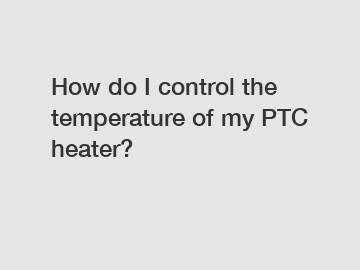How do I control the temperature of my PTC heater?
How do I control the temperature of my PTC heater?
PTC heaters, also known as Positive Temperature Coefficient heaters, are a popular choice for various applications due to their ability to maintain a consistent and controlled temperature. These heaters are widely used in industries such as automotive, aerospace, and electronics, as well as in appliances and consumer electronics. To properly control the temperature of a PTC heater, there are several factors to consider and various methods that can be used. In this article, we will explore these factors and methods to help you effectively control the temperature of your PTC heater.
Understanding the PTC Heater.

Before diving into temperature control methods, it is crucial to have a basic understanding of how PTC heaters work. PTC heaters are composed of a ceramic element that has a positive temperature coefficient, meaning that its resistance increases as the temperature rises. This characteristic allows PTC heaters to self-regulate and maintain a stable temperature when connected to a power source.
Factors Affecting Temperature Control.
Several factors can influence the temperature control of a PTC heater. These include the input voltage, the ambient temperature, the heat dissipation capability of the system, and the design of the heater itself. It is essential to consider these factors when implementing a temperature control mechanism for your PTC heater.
Temperature Control Methods.
1. Voltage regulation: One of the most common methods to control the temperature of a PTC heater is by regulating the input voltage. By adjusting the voltage, you can increase or decrease the amount of heat generated by the heater. This method is simple and effective, but it requires a voltage regulator circuit and may not offer precise temperature control.
2. Pulse Width Modulation (PWM): PWM is a technique that adjusts the duty cycle of a square wave to control the average power delivered to the heater. By modulating the width of the pulses, the heater's temperature can be precisely controlled. PWM offers more precise control compared to voltage regulation but requires a more complex control circuit.
3. Thermistors: Thermistors are temperature-sensitive resistors that can be used in conjunction with PTC heaters to provide temperature feedback. By measuring the resistance of the thermistor, it is possible to determine the temperature of the heater. This feedback can then be used to regulate the power supplied to the heater and maintain the desired temperature.
Closing Remarks.
Controlling the temperature of a PTC heater is essential to ensure safe and efficient operation. Factors such as input voltage, ambient temperature, and design play crucial roles in temperature control. By understanding these factors and utilizing appropriate temperature control methods such as voltage regulation, PWM, or thermistors, you can effectively control the temperature of your PTC heater.
If you require further assistance or have any questions regarding PTC heaters or temperature control, please do not hesitate to contact us. Our team of experts is here to provide guidance and support to help you meet your temperature control requirements.
Contact us to discuss your requirements of Hv Ptc Heater, Electric Vehicles with Heat Pumps, Ptc Fan Heater Means. Our experienced sales team can help you identify the options that best suit your needs.

Comments
0